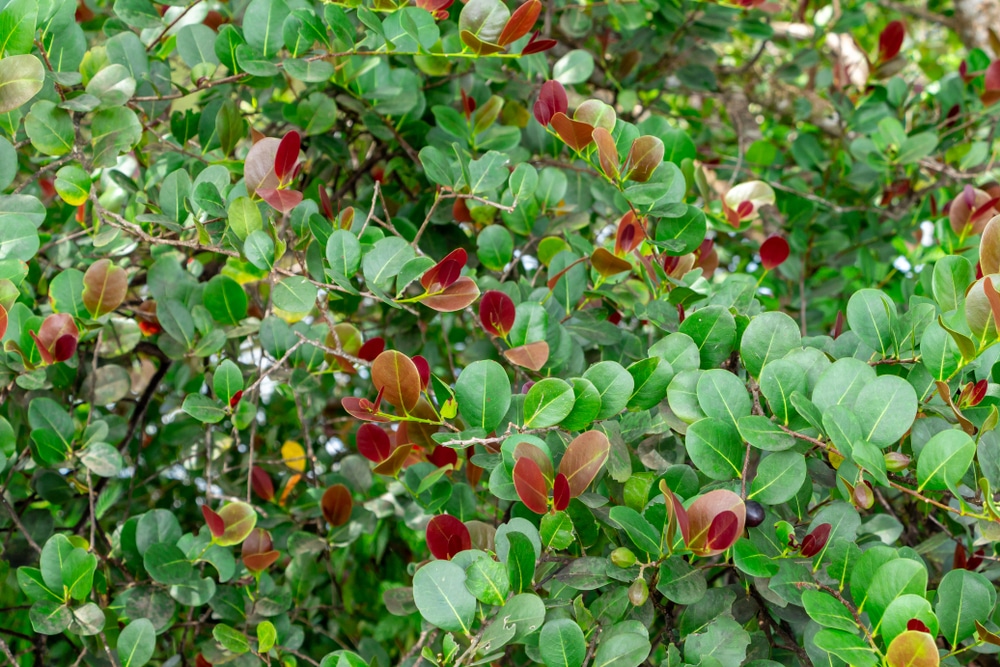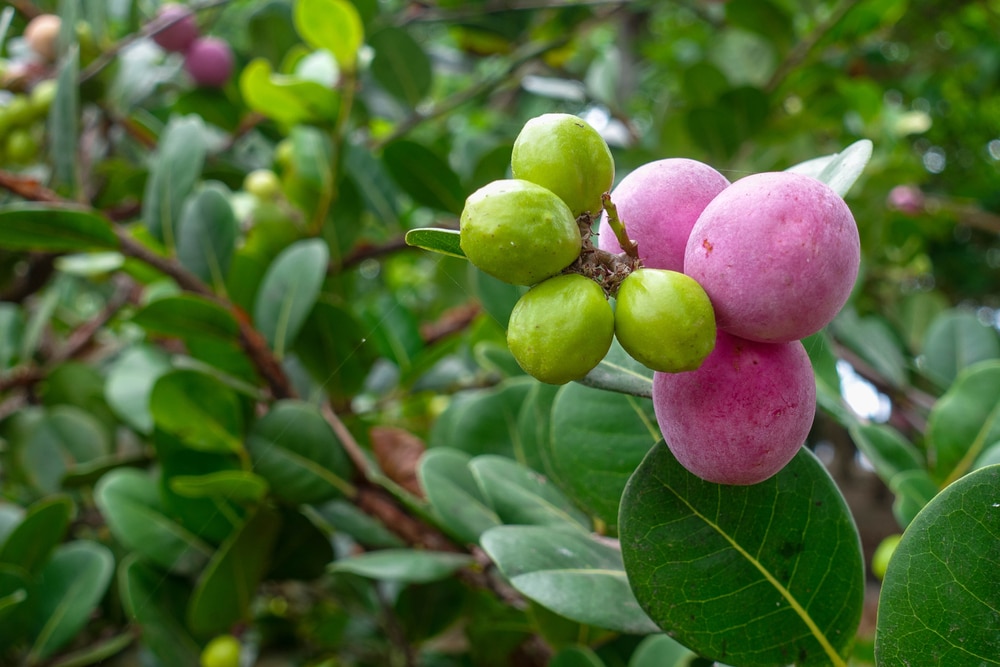The first time you lay eyes on a Cocoplum plant, you might think you see a mirage. These tropical beauties boast an array of colors that seem too vibrant to be real. But the Cocoplum is very much a reality, and it’s a sight to behold.
If you’re lucky enough to have one of these plants in your garden or yard, you’ll want to give it the care it deserves. Here’s everything you need to know about cocoplum care.

| Botanical Name | Chrysobalanus Icaco |
| Common Name | Cocoplum |
| Plant Type | Perennial |
| Flower Color | Small and white flowers growing in clusters |
| Size When Mature | In Inches |
| Bloom Time | 120-180 inches |
| Sun Requirements | Full to Partial Sun |
| USDA Hardiness Zones | 10 – 11 |
| Soil PH Range | 6.6-8.4 |
| Soil Type | Acidic, Neutral, Alkaline, and Well-draining |
| Water Needs | Low to Medium |
| Native Area | North America |
What You Need to Know About Cocoplum
The Cocoplum plant is native to North America, where it grows as a small tree or large shrub. It’s a member of the Chrysobalanaceae family and can grow up to 25 feet tall, but they typically stay between 10-15 feet tall.
They have short bright green leaves, usually 3 inches long, that have a leathery texture and an ovate shape. Additionally, they also have a reddish tint to their leaves, which makes them even more beautiful and adds a dramatic touch to the plant itself.
The flowers of the Cocoplum bloom during the spring and are small and white, normally growing in clusters. The fruits, on the other hand, are where this plant really shines.
The Cocoplum fruit is a small drupe that starts out white but ripens to a red or purple color. The fruits are about the size of a blueberry and have a mildly sweet flavor.
While the Cocoplum is a beautiful plant, it’s also quite tough. It’s resistant to drought and saltwater and can even handle being in direct sunlight. This makes the Cocoplum a perfect plant for coastal areas or places with hot summers.
However, the leaves of the Cocoplum are toxic to humans and animals if ingested, so be sure to keep them out of reach.
How to Care for Cocoplum
Here’s everything you need to know about growing and caring for a thriving Cocoplum:
Light
Being a tropical plant, the Cocoplum prefers full sun. But it can also tolerate partial shade, especially in hot climates. Ensuring the plant gets at least 6 hours of sunlight will help it produce more fruit and have its beautiful and distinct reddish tint on its leaves.
Water and Soil Needs
This tropical plant is quite drought-tolerant, so you don’t need to water it too often. In fact, overwatering can be just as harmful as underwatering. Let the topsoil dry out in between watering to prevent it from drowning.
When it comes to soil, the Cocoplum can grow in a wide range of soils, including sandy, loamy, and clay soils. As long as the soil is well-draining and has a pH range of 6.6-8.4, the Cocoplum will be happy and thriving.
Temperature Requirements
As a tropical plant, the Cocoplum does best in warm climates and is hardy in USDA zones 10-11. It can handle temperatures as low as 30-40 degrees Fahrenheit but will start to experience damage to its leaves below that point.
Growing the plant in a container is a great way to protect it during colder months. You can bring the container indoors or keep it in a garage or shed that doesn’t dip below 40 degrees Fahrenheit.
Fertilizer
The best fertilizer to use on a Cocoplant is a balanced granular fertilizer that’s meant for fruit trees. You can also use a slow-release fertilizer, which is more gentle on the plant and releases nutrients over time. Apply fertilizer to the soil around the tree in spring, summer, and fall. This ensures the plant has the nutrients it needs to produce fruit and stay healthy.
Common Diseases
Cocoplum is relatively disease-resistant, but there are a few diseases that can affect the plant. These include fungal diseases such as a black knot, plum pocket, and brown rot.
Black knot is a fungal disease that affects the branches and twigs of the Cocoplum. The fungus causes black, cancerous-looking growths to form on the plant. If left untreated, it can kill the plant. To prevent black knots, prune any infected branches and twigs.
Plum pocket is a fungal disease that affects the fruits of the Cocoplum. The fungus causes the fruits to develop small pockets that are filled with a black, tar-like substance. This substance is actually the fungus itself. It can cause the fruits to rot and fall off the plant. To avoid a plum pocket, prune any infected fruits and clean up any fallen fruit from the ground.
Finally, brown rot is another disease that can affect the fruits of the Cocoplum. The fungus causes the fruits to turn brown and rot. It can also cause the plant’s leaves to turn yellow and fall off. Brown rot can be controlled with fungicide sprays. Apply the fungicide in early spring and summer, when the fungus is most active.
Cocoplum Propagation
You can propagate Cocoplums by stem cuttings.
To propagate by stem cuttings, take a cutting from a healthy branch that’s about 6 inches long. After that, remove the lower leaves and plant the cutting in a pot filled with moistened potting mix. Keep the soil moist and wait for the cutting to root, which will take several weeks, usually around 4 to 6 weeks.
After the cutting has rooted, you can transplant it into a larger pot (for overwintering) or plant it in the ground, depending on the climate.

